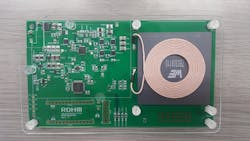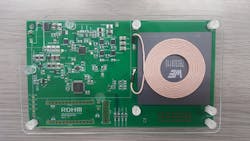This file type includes high resolution graphics and schematics when applicable.
The production of wireless charging transmitter and receiver chip-sets based on WPC and A4WP/PMA standards is picking up. Several mobile chipmakers are providing integrated circuits that support at least one of the standards. The wireless charging market is expanding from the smartphone market into other markets with great potential (e.g., the automotive, wearable, industrial, Internet of things (IoT), and medical markets).
Nowadays, most semiconductor companies are members of both the major wireless standards organizations. Chipmakers not only offer certified product solutions for low-power standard (5W), some of them had even started to offer certified higher-power solutions (such as 15W). For example, Rohm received certification from WPC (Wireless Power Consortium) for its reference design using the BD57020MWV wireless power transmitter IC and BD57015GWL wireless power receiver IC (Fig. 1). Both receiver and transmitter are certified to be compliant with the new Qi v1.2 standard for medium power. The Qi standard by WPC for medium power enables wireless charging of tablet PCs while allowing smartphones and other mobile devices to be charged up to three times faster than the existing low-power standard (5W). In addition, a Foreign Object Detection (FOD) function is included to provide greater safety by detecting foreign metallic objects before power transfer to protect against possible damage due to overheating.
Another example of wireless chargers becoming a new source of revenue is the announcement made by STMicroelectronics and WiTricity to develop integrated circuits (ICs). WiTricity (an active member of A4WP) and STMicroelectronics are developing semiconductor solutions that combine WiTricity’s foundational intellectual property and wireless power-transfer mixed-signal IC-design expertise with ST’s leadership in power-semiconductor design, fabrication, and packaging capabilities and resources.
has just removed the headphone jack in its latest Iphone 7 (Fig. 2), signaling that the company may finally be shifting toward wireless charging. But the potential adoption of wireless charging by Apple could also introduce yet a new standard, making the standards battle even more complicated. There is no unified wireless power standard and there is no interoperability between the two major standards (Qi and A4WP/PMA), but that has not stopped consumers from seeking out the new technology. Wireless power technology will continue to improve and grow into other markets; the battery-powered electric vehicle and the plug-in hybrid-vehicle are two markets that can benefit greatly from this technology. I can’t wait to see what comes next.
About the Author
Maria Guerra Blog
Power/Analog Editor
Maria Guerra is the Power/Analog Editor for Electronic Design. She is an Electrical Engineer with an MSEE from NYU Tandon School of Engineering. She has a very solid engineering background and extensive experience with technical documentation and writing. Before joining Electronic Design, she was an Electrical Engineer for Kellogg, Brown & Root Ltd (London. U.K.). During her years in the Oil and Gas Industry she was involved in a range of projects for both offshore and onshore designs. Her technical and soft skills bring a practical, hands-on approach to the Electronic Design team.




